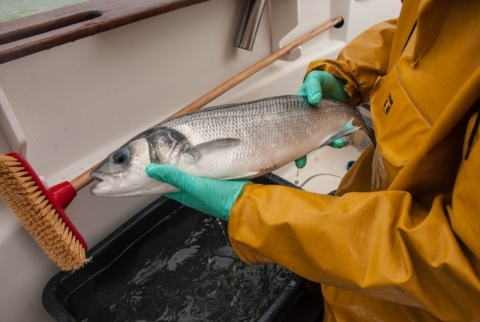European seabass as test case in innovative acoustic telemetry research
The European seabass is a highly tasted species, loved by sea anglers. Since 2010, this predatory fish suffers from a decline in the southern North Sea. To support the restoration policy, the Flanders Marine Institute (VLIZ) is starting this summer to following seabass with so-called 'combination transmitters'. Special about these transmitters is that they not only register the presence of the fish, but also carry out continuous measurements of water depth and temperature. VLIZ calls on fishermen and beachcombers to keep track of found transmitters and to report them via <a href="mailto:info@lifewatch.be">info@lifewatch.be</a>.

European seabass is a fast predatory fish that adapts easily to different living conditions (habitat, temperature, salt content, prey species ...). In the Atlantic Ocean the species takes refuge in summer in rich shallow coastal areas and river water to feed. In winter, mature fish migrate to more southerly, deeper spots to mate. With the innovative research of VLIZ – together with the Institute for Nature and Forest Research (INBO) and Ghent University – we want to get grip on the distribution and movements of the European seabass in the southern North Sea (including the Belgian part). The lack of ecological knowledge about seabass prevents an efficient conservation policy. The number of seabass has fallen sharply in the southern North Sea since 2010, after which catch limiting measures were introduced for commercial and recreational fishermen. For example, recreational sea fishers are still allowed to catch seabass, but they have to release them back alive.
VLIZ will investigate the distribution and migration of seabass by means of telemetry. This technique uses transmitters and receiving stations. In 2018 VLIZ will implant – under narcosis – the so called 'combination transmitters' in 40 seabass individuals. With this type of transmitter two data streams are generated. On the one hand, the transmitter sends out a sound signal which can be detected by the receiving stations when the fish is nearby, and thus indicates where the fish is located. On the other hand, the transmitter itself continuously records measurements of depth and temperature.
This research will be the first worldwide to use this type of 'combination transmitter'. VLIZ makes a two-fold call. On the one hand, we are looking for experienced seabass fishermen, commercial or recreational, to help catch and equip this challenging fish with transmitters. On the other hand, we call for fishermen and beachcombers to send the found transmitters - with the data on it – back to us. The transmitters are bright orange-red colored and can wash ashore after death. When you find a transmitter, you can contact us via info@lifewatch.be.
"All help is welcome in increasing the knowledge of the European seabass in the Belgian part of the North Sea. It contributes to better informed policy decisions for the conservation of this spectacular species present in our waters," says lead researcher Dr Jan Reubens.
Telemetry is not a new technique for VLIZ. Since 2014, we developed a permanent 'Acoustic Receiver Network' within the framework of the European LifeWatch project (www.lifewatch.be). This network, managed by VLIZ and INBO, now comprises 170 receiving stations. Since the start-up more than 800 animals from 14 different species have been equipped with transmitters. This network allows to detect the presence of tagged fish in the Belgian part of the North Sea, the Westerschelde and a number of Belgian rivers and canals.
VLIZ will investigate the distribution and migration of seabass by means of telemetry. This technique uses transmitters and receiving stations. In 2018 VLIZ will implant – under narcosis – the so called 'combination transmitters' in 40 seabass individuals. With this type of transmitter two data streams are generated. On the one hand, the transmitter sends out a sound signal which can be detected by the receiving stations when the fish is nearby, and thus indicates where the fish is located. On the other hand, the transmitter itself continuously records measurements of depth and temperature.
This research will be the first worldwide to use this type of 'combination transmitter'. VLIZ makes a two-fold call. On the one hand, we are looking for experienced seabass fishermen, commercial or recreational, to help catch and equip this challenging fish with transmitters. On the other hand, we call for fishermen and beachcombers to send the found transmitters - with the data on it – back to us. The transmitters are bright orange-red colored and can wash ashore after death. When you find a transmitter, you can contact us via info@lifewatch.be.
"All help is welcome in increasing the knowledge of the European seabass in the Belgian part of the North Sea. It contributes to better informed policy decisions for the conservation of this spectacular species present in our waters," says lead researcher Dr Jan Reubens.
Telemetry is not a new technique for VLIZ. Since 2014, we developed a permanent 'Acoustic Receiver Network' within the framework of the European LifeWatch project (www.lifewatch.be). This network, managed by VLIZ and INBO, now comprises 170 receiving stations. Since the start-up more than 800 animals from 14 different species have been equipped with transmitters. This network allows to detect the presence of tagged fish in the Belgian part of the North Sea, the Westerschelde and a number of Belgian rivers and canals.



